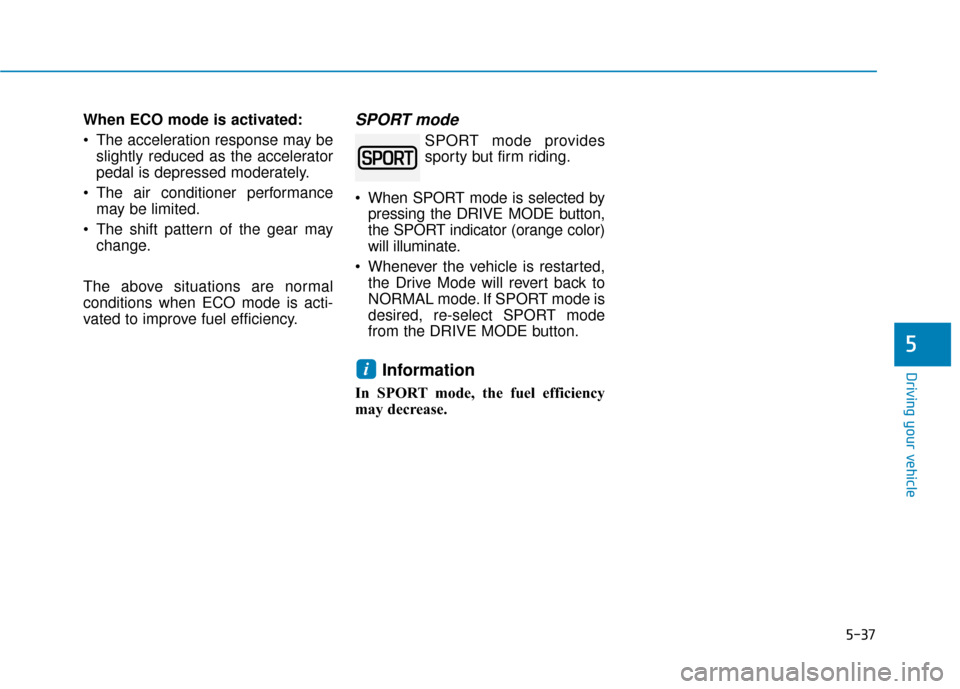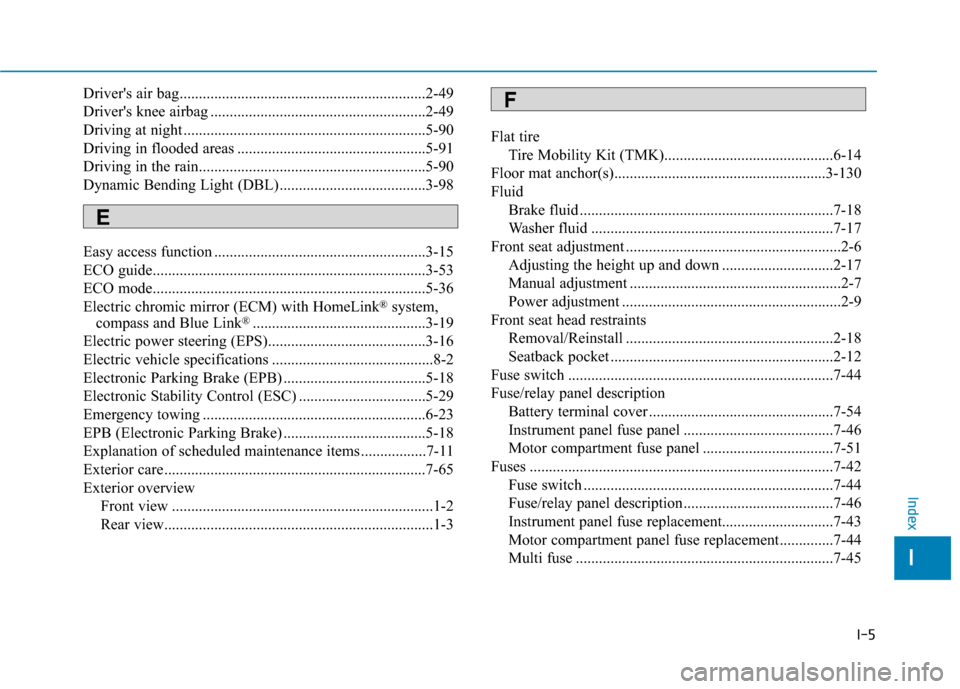2018 Hyundai Ioniq Electric ECO mode
[x] Cancel search: ECO modePage 297 of 541

5-36
Driving your vehicle
The drive mode may be selected
according to the driver's preference
or road condition.
The system resets to be in the NOR-
MAL mode (except if it is in ECO
mode), when the vehicle is restarted.
Information
If there is a problem with the instru-
ment cluster, the drive mode will be in
NORMAL mode and may not change
to ECO mode or SPORT mode. The mode changes, as below,
whenever the DRIVE MODE button
is pressed.
When NORMAL mode is selected,
it is not displayed on the instrument
cluster.
ECO mode
ECO mode improves bat- tery charge use efficiency
for eco-friendly driving.
When ECO mode is selected by pressing the DRIVE MODE button,
the ECO indicator (green color) will
illuminate.
If the vehicle is set to ECO mode, when the vehicle is turned OFF
and restarted the Drive Mode set-
ting will remain in ECO mode.
Information
Battery charge use efficiency depends
on the driver's driving habit and road
condition.
i
i
D DR
RI
IV
V E
E
M
M O
OD
DE
E
I
IN
N T
TE
EG
G R
RA
A T
TE
ED
D
C
C O
O N
NT
TR
R O
O L
L
S
S Y
Y S
ST
T E
EM
M
(
( I
IF
F
E
E Q
Q U
UI
IP
P P
PE
ED
D )
)
OAEE056010N
ECO
NORMAL SPORT
Page 298 of 541

5-37
Driving your vehicle
5
When ECO mode is activated:
The acceleration response may beslightly reduced as the accelerator
pedal is depressed moderately.
The air conditioner performance may be limited.
The shift pattern of the gear may change.
The above situations are normal
conditions when ECO mode is acti-
vated to improve fuel efficiency.SPORT mode
SPORT mode provides
sporty but firm riding.
When SPORT mode is selected by pressing the DRIVE MODE button,
the SPORT indicator (orange color)
will illuminate.
Whenever the vehicle is restarted, the Drive Mode will revert back to
NORMAL mode. If SPORT mode is
desired, re-select SPORT mode
from the DRIVE MODE button.
Information
In SPORT mode, the fuel efficiency
may decrease.
i
Page 302 of 541

5-41
Driving your vehicle
5
The second stage alarm may bedeactivated.
- To deactivate the warning chime:
Go to the 'User Settings → Driving
Assist and deselect Blind Spot
Detection Sound' on the LCD dis-
play.
- To activate the warning chime:
Go to the 'User Settings → Driving
Assist and select Blind Spot
Detection Sound' on the LCD dis-
play.
Information
The warning chime function helps
alert the driver. Deactivate this func-
tion only when it is necessary.
For more information, refer to
"LCD Display Modes" in chapter 3.
RCTA (Rear Cross Traffic
Alert) (if equipped)
The Rear Cross Traffic Alert function
monitors approaching cross traffic
from the left and right side of the
vehicle when your vehicle is in
reverse.
Operating conditions
To operate:
Go to the 'User Settings → Driving
Assist and select Rear Cross Traffic
Alert' on the LCD display.
The system will turn on and standby
to activate. The system will activate
when vehicle speed is below 6 mph
(10 km/h) and with the gear in R
(Reverse).
If the function is deselected from the
instrument cluster, the function will
deactivate.
For more information, refer to
"LCD Display Modes" in chapter 3.
Information
• The last selected setting (ON or OFF) of the RCTA is remained in
the system.
• The system will activate when vehi- cle speed is below 6.2 mph (10 km/h)
and with the shift lever in R
(Reverse).
• The Rear Cross Traffic Alert (RCTA) detecting range is approxi-
mately 1 ft ~ 65 ft (0.5 m ~ 20 m) in
the direction of both lateral sides of
the vehicle.
An approaching vehicle will be
detected if their vehicle speed is
within 2.5 ~ 22.5 mph (4 km/h ~36
km/h).
Note that the detecting range may
vary under certain conditions. As
always, use caution and pay close
attention to your surroundings
when backing up your vehicle.
i
i
Page 344 of 541

5-83
Driving your vehicle
5
To convert to Cruise Control
mode
The driver may choose to switch to
use the conventional Cruise Control
mode (speed only control function)
by following these steps:
1. Push the CRUISE button on thesteering wheel to turn the system
on. The cruise ( ) indi-
cator will illuminate.
2. Push and hold the Vehicle-to- Vehicle Distance button for more
than 2 seconds.
3. Choose between "Smart Cruise Control" and "Cruise Control".
When the system is cancelled using
the CRUISE button or the CRUISE
button is used after the vehicle is in
the ready ( ) mode, the Smart
Cruise Control mode will turn on.
Limitations of the system
The Smart Cruise Control System
may have limits to its ability to detect
distance to the vehicle ahead due to
road and traffic conditions.
On curves
The Smart Cruise Control System may not detect a moving vehicle in
your lane, and then your vehicle
could accelerate to the set speed.
Also, the vehicle speed will
decrease when the vehicle ahead
is recognized suddenly.
Select the appropriate set speed on curves and apply the brakes or
accelerator pedal if necessary.
OAE056100
When using the conventional
Cruise Control mode, you must
manually adjust the distance to
other vehicles by depressing
the accelerator or brake pedal.
The system does not automati-
cally adjust the distance to
vehicles in front of you.
WARNING
Page 422 of 541

7-37
7
Maintenance
Maximum Inflation Pressure
The maximum air pressure to which
a cold tire may be inflated. The max-
imum air pressure is molded onto the
sidewall.
Maximum Load Rating
The load rating for a tire at the maxi-
mum permissible inflation pressure
for that tire.
Maximum Loaded VehicleWeight
The sum of curb weight; accessory
weight; vehicle capacity weight; and
production options weight.
Normal Occupant Weight
The number of occupants a vehicle
is designed to seat multiplied by 150
pounds (68 kg).
Occupant Distribution
Designated seating positions.
Outward Facing Sidewall
An asymmetrical tire has a particular
side that faces outward when mount-
ed on a vehicle. The outward facing
sidewall bears white lettering or
bears manufacturer, brand, and/or
model name molding that is higher or
deeper than the same moldings on
the inner facing sidewall.
Passenger (P-Metric) tire
A tire used on passenger cars and
some light duty trucks and multipur-
pose vehicles.
Ply
A layer of rubber-coated parallel
cords.
Pneumatic tire
A mechanical device made of rubber,
chemicals, fabric and steel or other
materials, that, when mounted on an
automotive wheel provides the trac-
tion and contains the gas or fluid that
sustains the load.
Pneumatic options weight
The combined weight of installed
regular production options weighing
over 5 lb. (2.3 kg) in excess of the
standard items which they replace,
not previously considered in curb
weight or accessory weight, includ-
ing heavy duty breaks, ride levelers,
roof rack, heavy duty battery, and
special trim.
Recommended InflationPressure
Vehicle manufacturer's recommend-
ed tire inflation pressure as shown
on the tire placard.
Page 424 of 541

7-39
7
Maintenance
All Season Tires
HYUNDAI specifies all season tires
on some models to provide good
performance for use all year round,
including snowy and icy road condi-
tions. All season tires are identified
by ALL SEASON and/or M+S (Mud
and Snow) on the tire sidewall. Snow
tires have better snow traction than
all season tires and may be more
appropriate in some areas.
Summer Tires
HYUNDAI specifies summer tires on
some models to provide superior
performance on dry roads. Summer
tire performance is substantially
reduced in snow and ice. Summer
tires do not have the tire traction rat-
ing M+S (Mud and Snow) on the tire
side wall. If you plan to operate your
vehicle in snowy or icy conditions,
HYUNDAI recommends the use of
snow tires or all season tires on all
four wheels.
Snow Tires
If you equip your car with snow tires,
they should be the same size and
have the same load capacity as the
original tires. Snow tires should be
installed on all four wheels; other-
wise, poor handling may result. Snow
tires should carry 4 psi (28 kPa)
more air pressure than the pressure
recommended for the standard tires
on the tire label on the driver’s side of
the center pillar, or up to the maxi-
mum pressure shown on the tire
sidewall, whichever is less. Do not
drive faster than 75 mph (120 km/h)
when your vehicle is equipped with
snow tires.
Radial-Ply Tires
Radial-ply tires provide improved
tread life, road hazard resistance and
smoother high speed ride. The radi-
al-ply tires used on this vehicle are of
belted construction, and are selected
to complement the ride and handling
characteristics of your vehicle.
Radial-ply tires have the same load
carrying capacity, as bias-ply or bias
belted tires of the same size, and use
the same recommended inflation
pressure. Mixing of radial-ply tires
with bias-ply or bias belted tires is
not recommended. Any combina-
tions of radial-ply and bias-ply or bias
belted tires when used on the same
vehicle will seriously deteriorate
vehicle handling. The best rule to fol-
low is: Identical pairs of radial-ply
tires should always be used as a set
for the front tires and a set for the
rear tires.
Page 472 of 541

I-4
Charging door .................................................................3-50
Checking tire inflation pressure ......................................7-28
Child restraint system (CRS) ..........................................2-36Booster seats...............................................................2-39
Forward-facing child restraint system........................2-39
Installing a child restraint system (CRS) ...................2-39
Lower anchors and tether for children (LATCH system) .....................................................2-40
Rearward-facing child restraint system......................2-38
Securing a child restraint system seat with "Tether Anchor" system ..........................................2-43
Securing a child restraint system with a lap/ shoulder belt ............................................................2-44
Securing a child restraint system withthe LATCH anchors system ........................................................2-42
Selecting a child restraint system (CRS) ...................2-37
Child-protector rear door lock ........................................3-12
Climate control air filter replacement.............................7-18
Clock ........................................................................\
.....3-129
Clothes hanger ..............................................................3-130
Combined instrument, see instrument cluster ................3-51
Consumer information ......................................................8-9
Coolant ........................................................................\
....7-12
Cooling fluid, see coolant ...............................................7-12
Cruise control system .....................................................5-67
Cup holder.....................................................................3-1\
25
Curtain air bags ...............................................................2-51 Dashboard illumination, see instrument panel
illumination..................................................................3-52
Dashboard, see instrument cluster ..................................3-51
Day/night rearview mirror ..............................................3-19
Daytime running light (DRL) .........................................3-94
Defogging (Windshield) ...............................................3-120
Defroster .......................................................................3\
-106 Rear window defroster .............................................3-106
Defrosting (Windshield) ...............................................3-120
Dimensions .......................................................................8\
-2
Display illumination, see instrument panel illumination..................................................................3-52
Displays, see instrument cluster .....................................3-51
Distance to empty ...........................................................3-55
Door locks ........................................................................\
.3-9 Auto door lock/unlock features ..................................3-12
Central door lock switch ............................................3-11
Child-protector rear door lock....................................3-12
Drinks holders, see cup holders ....................................3-125
Drive mode integrated control system ............................5-36 ECO mode ..................................................................5-36
SPORT mode ..............................................................5-37
Driver position memory system .....................................3-14 Easy access function ..................................................3-15
Recalling memory positions .......................................3-15
Storing memory positions ..........................................3-14
Index
D
Page 473 of 541

I-5
Driver's air bag................................................................2-49
Driver's knee airbag ........................................................2-49
Driving at night ...............................................................5-90
Driving in flooded areas .................................................5-91
Driving in the rain...........................................................5-90
Dynamic Bending Light (DBL)......................................3-98
Easy access function .......................................................3-15
ECO guide.......................................................................3\
-53
ECO mode.......................................................................5\
-36
Electric chromic mirror (ECM) with HomeLink
®system,
compass and Blue Link®.............................................3-19
Electric power steering (EPS).........................................3-16
Electric vehicle specifications ..........................................8-2
Electronic Parking Brake (EPB) .....................................5-18
Electronic Stability Control (ESC) .................................5-29
Emergency towing ..........................................................6-23
EPB (Electronic Parking Brake) .....................................5-18
Explanation of scheduled maintenance items .................7-11
Exterior care....................................................................7-65\
Exterior overview Front view ....................................................................1-2
Rear view......................................................................1-\
3 Flat tire
Tire Mobility Kit (TMK)............................................6-14
Floor mat anchor(s).......................................................3-130
Fluid Brake fluid ..................................................................7-18
Washer fluid ...............................................................7-17
Front seat adjustment ........................................................2-6 Adjusting the height up and down .............................2-17
Manual adjustment .......................................................2-7
Power adjustment .........................................................2-9
Front seat head restraints Removal/Reinstall ......................................................2-18
Seatback pocket ..........................................................2-12
Fuse switch .....................................................................7-4\
4
Fuse/relay panel description Battery terminal cover ................................................7-54
Instrument panel fuse panel .......................................7-46
Motor compartment fuse panel ..................................7-51
Fuses ........................................................................\
.......7-42 Fuse switch .................................................................7-44
Fuse/relay panel description .......................................7-46
Instrument panel fuse replacement.............................7-43
Motor compartment panel fuse replacement..............7-44
Multi fuse ...................................................................7-45
I
Index
E
F